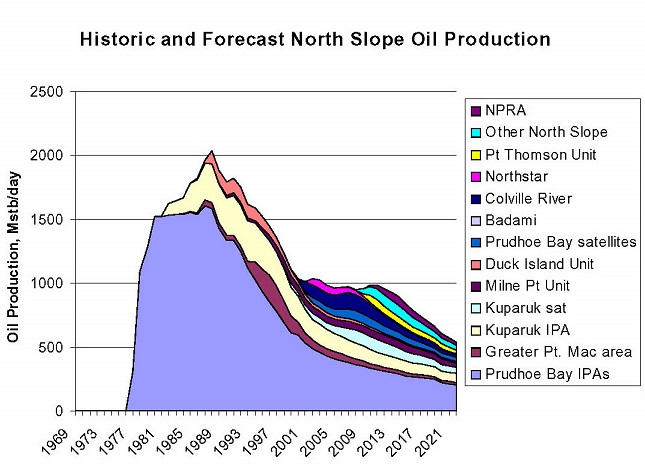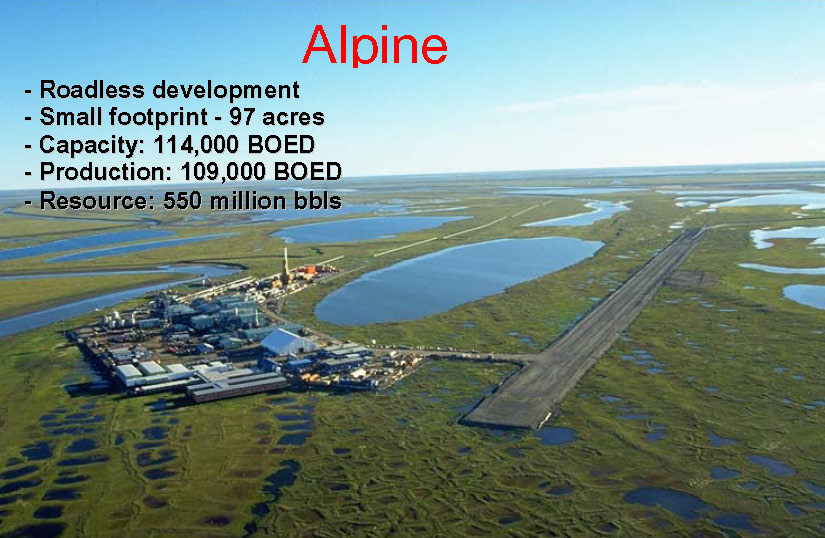The Alaska North Slope has been a major U.S. oil production province since production was initiated in Prudhoe Bay field in 1976. ANS oil production has decreased to just under 1 million barrels per day in 2004 from 2.04 million barrels per day in 1988 (falling to 17 percent of total U.S. crude oil production from about 25 percent). Production is projected to remain about 1 million barrels per day through 2010 (see chart). The downward production trend has been dominated by the continuing decline of Prudhoe Bay production, but this decline is being partially offset by continued development of onshore and offshore fields near the existing infrastructure and development of projected resources in the National Petroleum Reserve-Alaska (NPR-A) and Beaufort Sea. Technology advances in the last 10 years, such as 3-D seismic and extended-reach and multilateral drilling, have made numerous small satellite fields near the Prudhoe Bay and Kuparuk River units economically viable. Alpine field in the Colville River Unit and the offshore Northstar field are examples of stand-alone fields that have been developed with advanced technology for drilling and production and reduction of environmental impacts. The discovery of Alpine field and the play type it represents is in large part responsible for the recent increase in reserves estimated for NPR-A. These developments have slowed the decline of ANS production, but continued access to federal lands and aggressive leasing and development are essential to maintain the viability of the Trans-Alaska Pipeline System and other infrastructure in the long term to support future development.
No ANS natural gas has been sold except for local use on the North Slope. The recoverable natural gas is estimated to be 26 trillion cubic feet (TCF) for Prudhoe Bay field and 8 TCF for Point Thomson field. Estimates for additional recoverable natural gas in Arctic Alaska are over 150 TCF and will be described in the report. Produced gas is being reinjected into Prudhoe Bay field at a rate of about 8.7 billion cubic feet per day. This injection has had a positive impact on recovery efficiency in the Prudhoe Bay Unit. In addition, miscible injectant, a combination of methane and natural gas liquids stripped from the produced natural gas, has been used effectively for enhanced oil recovery in Prudhoe Bay and Kuparuk River oilfields. Use of miscible injectant for enhancing recovery from the huge heavy oil resource overlying the Kuparuk River Unit (25 to 30 billion barrels OOIP, or original-oil-in-place) is expected to be economically feasible when coupled with new technology for multilateral horizontal wells and new completion technology.
Project Results
Input was provided to the Arctic Monitoring and Assessment Program (AMAP) under the Arctic Council on behalf of the U.S. Department of State for use in the AMAP chapter on Oil and Gas Development in the Arctic describing the history and status of U.S. arctic oil and gas development. Most of the assessment and analysis described in Tasks 1, 2, and 3 has been completed and is in review for issuing a draft report.
Benefits
The results will provide a source of detailed information for planning and decision-making by the U.S. Department of Energy and other federal and state resource and regulatory agencies in order to improve the prospects for continued development of Alaska North Slope (ANS) oil and gas through effective public policy.
Project Summary
The project scope will include currently known onshore and offshore fields (developed and undeveloped), development of heavy oil production in West Sak and Ugnu, and prospective development areas such as NPR-A, the Central North Slope and Foothills area, and the 1002 area of the Arctic National Wildlife Refuge (ANWR). In prospective development areas, estimated characteristics, locations, and economic potential of the undiscovered oil and gas resources on ANS state, federal, and native lands will be determined using the latest available geological data and analytic reservoir engineering calculations. Development of smaller fields and development by independents hinge on infrastructure and facility-sharing being available at reasonable costs. The interaction of infrastructure, environmental regulations, advanced technology development, and development of a gas pipeline on the future viability of ANS oil and gas production will be evaluated and described. Study results also will be used as a core contribution to a larger study commissioned by AMAP.
The project includes three interrelated tasks:
- Perform a comprehensive review, assessment, and description of the ANS oil and gas resource base.
- Perform a technical and economic analysis of the producing fields and future oil and gas developments (known and future potential), based on location. Evaluate the impacts of future development across the North Slope (including NPR-A and ANWR 1002) and the technical and economic impact of major gas sales options on currently producing ANS oilfields and future gas and oilfield developments.
- Document and evaluate the environmental and regulatory issues that control and influence oil and gas exploration and development on the North Slope (INL subcontract).





